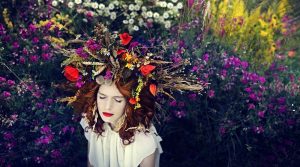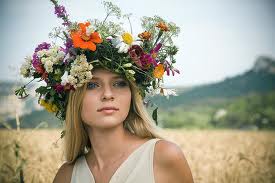
 The vinok was always decorated with different coloured ribbons, which were cut lower than a girl’s braids in order to hide them. The central ribbon was usually light brown, symbolizing the land and soil, then came yellow ribbons, symbolizing the sun, followed by light green and dark green - beauty and youth, light blue and dark blue - sky and water, which give strength and health, orange, symbolizing bread, violet - wisdom, crimson - truth and sincerity and pink - prosperity. White ribbons were intertwined only if they were embroidered with silver and gold (the sun on the left side of the vinok and the moon on the right). Non-embroidered ribbons were not added to the vinok as they commemorated the dead. Girls used red ribbons to intertwine poppies into their wreaths - symbols of grief and magic.
Orphans wove blue ribbons into their hair and wreaths. People bestowed lavish gifts, bread and money on young girls wearing these decorative head wreaths and wished them happiness and prosperity. The girls, in turn, expressed their gratitude by giving them a ribbon from their wreath.
In Ukraine, the vinok is a solar symbol. Girls wearing a vinok were linked to the rising sun. The vinok was also a symbol of glory, victory, holiness, success, power, peace, sun and authority. It signified purity and maiden youth.
The vinok was always decorated with different coloured ribbons, which were cut lower than a girl’s braids in order to hide them. The central ribbon was usually light brown, symbolizing the land and soil, then came yellow ribbons, symbolizing the sun, followed by light green and dark green - beauty and youth, light blue and dark blue - sky and water, which give strength and health, orange, symbolizing bread, violet - wisdom, crimson - truth and sincerity and pink - prosperity. White ribbons were intertwined only if they were embroidered with silver and gold (the sun on the left side of the vinok and the moon on the right). Non-embroidered ribbons were not added to the vinok as they commemorated the dead. Girls used red ribbons to intertwine poppies into their wreaths - symbols of grief and magic.
Orphans wove blue ribbons into their hair and wreaths. People bestowed lavish gifts, bread and money on young girls wearing these decorative head wreaths and wished them happiness and prosperity. The girls, in turn, expressed their gratitude by giving them a ribbon from their wreath.
In Ukraine, the vinok is a solar symbol. Girls wearing a vinok were linked to the rising sun. The vinok was also a symbol of glory, victory, holiness, success, power, peace, sun and authority. It signified purity and maiden youth.


